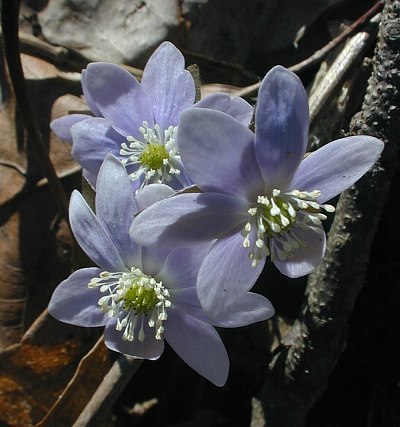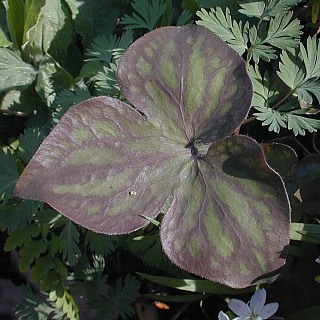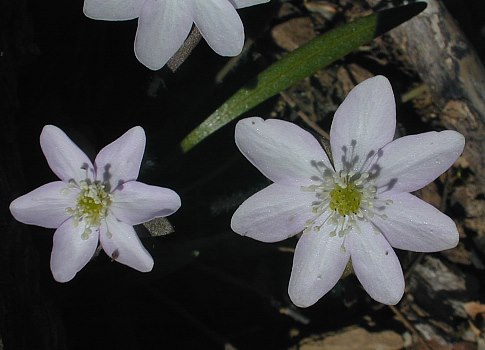Description: This herbaceous perennial plant is about 3-6" tall. It consists of a tuft of basal leaves that develops during the late spring and persists through the winter. These leaves are up to 3" long and across; they have slender petioles up to 6" long. Each leaf is palmately divided into 3 lobes; the lobes are oval-ovate and approximately the same size. The smooth upper surface of each leaf can be green, brownish green, reddish brown, or contain patches of the preceding colors; usually, the upper surface is more green during the summer, but become reddish brown during the winter. The leaf margins are smooth; for var. acuta, the tips of the lobes are rather pointed in mature leaves.

A mature plant will produce a tuft of flowers on long stalks during early to mid-spring, by which time the basal leaves that persisted during the winter may have withered away. Each flower occurs on a naked hairy stalk about 3-4" long; this stalk is often reddish green or reddish brown. The flower may be erect or it may nod on its stalk. Each flower is up to 1" across, consisting of 5-11 petal-like sepals, a green cluster of carpels in its center, and numerous white stamens surrounding the carpels. The sepals are white, pastel pink, or pastel blue; each sepal is oblong-oval in shape. At the base of each flower, there are 3 leafy bracts that are lanceolate, ovate, or oval in shape. These bracts are reddish green or reddish brown, hairy across the outer surface, and shorter than the sepals. The blooming period occurs during early to mid-spring and lasts about 2-3 weeks for a colony of plants; however, individual flowers are short-lived. The carpels turn brown and become beaked achenes that are often pubescent. The root system consists of a tuft of fibrous roots. This plant spreads by reseeding itself.

Cultivation:
The
preference is dappled sunlight during the spring and light shade during
the summer. The basal leaves should be left undisturbed during the
winter. The soil should be well-drained, loamy, and can contain some
rocky material, including pieces of limestone; a thin-layer of decaying
leaves is also beneficial.
Range & Habitat:
The native Sharp-Lobed Hepatica is occasional in wooded areas of
central and
northern Illinois; it is uncommon or absent in southern Illinois (see Distribution
Map). Habitats include upland deciduous woodlands, rocky
bluffs, the slopes of bluffs, and limestone cliffs (where some shade
occurs). Sharp-Lobed Hepatica occurs in high quality wooded areas where
the original flora is largely intact. Sometimes it is cultivated as a
rock garden plant. While Sharp-Lobed Hepatica is native to North
America, the typical variety of Hepatica, Hepatica nobilis
nobilis, occurs in Eurasia.

Faunal
Associations:
Small bees collect pollen from the flowers, while Syrphid flies and
other flies feed on the pollen. Bee visitors include honeybees, Small
Carpenter bees, Andrenid bees, and Halictid bees. Nectar is not
provided by the flowers. Chipmunks reportedly eat the achenes. The
brownish green basal leaves are poisonous and somewhat camoflaged; it
seems unlikely that they are eaten by mammalian herbivores to any
significant extent.
Photographic Location:
The photographs of the blue and white flowers were taken at Kickapoo
State Park, Vermilion County, Illinois, while the photographs of the
pink flowers and basal leaf were taken on a sloping bank of the
Sangamon river in Allerton Park, Piatt County, Illinois.

Comments: The flowers of Sharp-Lobed Hepatica bloom earlier than most spring-blooming wildflowers of woodlands. They are delicately attractive and have a tendency to blow about on their slender stems in the wind. Another native variety of this plant species is Hepatica nobilis obtusa (Round-Lobed Hepatica), which has a very similar appearance, except that the lobes of its basal leaves are well-rounded rather than pointed. This latter variety is apparently restricted to NE Illinois. Sometimes these two varieties intergrade where their ranges overlap. Some authorities refer to Sharp-Lobed Hepatica as Hepatica acutiloba, while Round-Lobed Hepatica is referred to as Hepatica americana. Another common name for Hepatica is Liverleaf, which refers to the appearance and shape of the leaves.